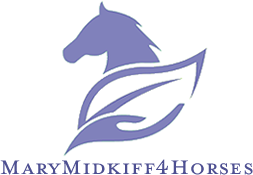Key to Balance for Female Equestrians Start by locating the hip joint
I wrote a book that was released in 1996 “Fitness, Performance and the Female Equestrian” (Wiley Publishing) providing definitive information for the female rider. It was much needed then and it is just as relevant today for knowledge or the female rider as an athlete, resources just for her and information on how to make positive changes to improve and maximize your riding comfort, safety and effectiveness. This blog is to get you started. You are one of many thousands looking for and needing these tools for you to keep riding and riding for a long time. I want to give back what I have learned since starting the Women & Horses program in 1992, writing books and articles, providing clinics and workshops around the world. 80% of all horse riders in the U.S. and the U.K. are girls and women!

As a passionate rider myself, I was and still am interested in finding balance and neutral pelvis when I sit in the saddle. I’m 25 years older now so I am even more aware of how important it is to know and learn this information for the female equestrian athlete.
Why? Because I want to be comfortable; I don’t want to be sore, swollen or chaffed in my crotch; I want to be safe; I want to ride with balance, control and effectiveness; and I want to flow with the horse’s motion.
From talking with other women who ride, they want the same. In many cases we just grin and bear it and don’t mention the unmentionable!
Does this graphic below look in some way familiar? When you are out of balance and alignment, the saddle does not support your balance you will tip forward when the horse is startled, spooks, jumps, or stops!
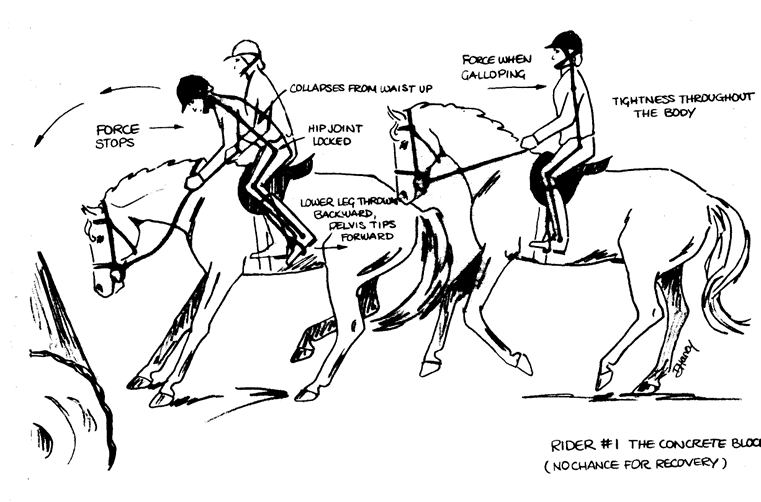
Why? Because the typical saddles don’t fit our pelvic and hip joint anatomy; the horse we ride may have conformation that does not support a balanced level ride forward; we are stuck in trying to “sit up” in the saddle by pulling our shoulders back and arching our lower back; we have no idea how to isolate the hip joint from the rest of the body and believe we bend at the waist; we are afraid to say anything to anyone for fear we might be complaining about something others think is insignificant; we don’t know how to change our body to be in balance; what is neutral pelvis anyway?; why don’t guys have this trouble; how do I change my innate reaction of gripping and tightening; how come some people can sit the trot and canter comfortably and others bounce a great deal; and what can you do about it?!!!
For one, the people in the tack or equipment store are probably not going to know how to help you other than offer you protective underwear, sticky breeches, tell you to talk to your instructor or go see a doctor. I hope by now they are well educated on this topic but I am not sure. You can speak to your instructor but what if you are too embarrassed or they won’t admit they don’t know how to help you. You could try asking friends how they get around sensitive issues (dare we mention crotch pain, swelling, soreness, chaffing!!)
It amazes me that we are in 2023 and still there are only small pockets of instructors and riders with the awareness, the education, the resources and the instruction for how to align the female body in the saddle. I still see the “chair” seat often in all disciplines which sets the female rider up for failure, pain, injury, instability and lack of control. Or the rider who has the entire leg down from the hip swinging forward and back on the horse while her back remains stiff. Or the rider who has to use her entire body in a jerk motion backward to half halt the horse. Or the rider that tucks forward and grips with the knees when the horse spooks. Whatever, these are forms of compensation for not being aligned and balanced.
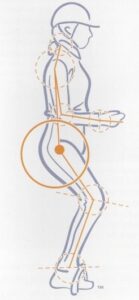 All of these are typical and common symptoms of inappropriate saddle fit for the female rider; a body that is not in alignment to free the extremities; a body that is either ahead of or behind the motion of the horse; a body that is unaware of how to find, establish and re-balance her own neutral pelvic structure.
All of these are typical and common symptoms of inappropriate saddle fit for the female rider; a body that is not in alignment to free the extremities; a body that is either ahead of or behind the motion of the horse; a body that is unaware of how to find, establish and re-balance her own neutral pelvic structure.
As you can see in the diagram the center of our body for riding is the hip joint. The hip joint is not on or around your waist. It is where you would measure the hip if you were taking your bust, waist and hip sizes. It is where the pelvis meets the femur or thigh bone. It is a ball joint that moves in many directions along with muscle and nerve intervention. This is where we all start!!
So, find your hip joint first and foremost. It’s easiest standing. Feel through the padding of your body and find that bony point. Now bend forward without bending at the waist. Come back up and lift your leg until your thigh is parallel with the floor. Now you can see you have two moving parts: Above the hip joint and below the hip joint.
Practice this on the ground standing first. Now sit in a chair with your back straight. Place your hands on your hip joints and feel what happens when you bend all the way forward toward with your chin toward your knees; then come back up. Now lift one leg at a time and feel the muscles work in and around your hip joint. Again you are in two parts hinging from the hip joints. This is how we are going to approach riding.
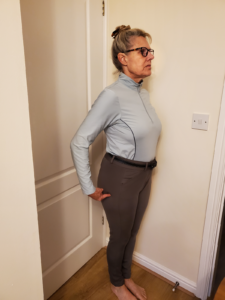
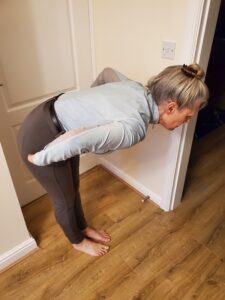
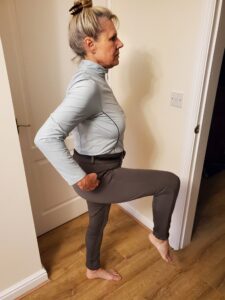
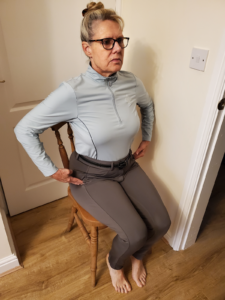
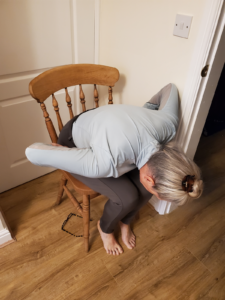
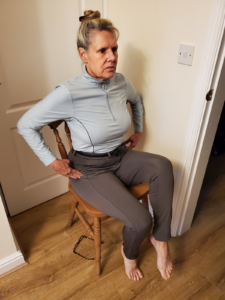
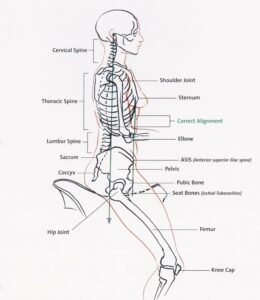
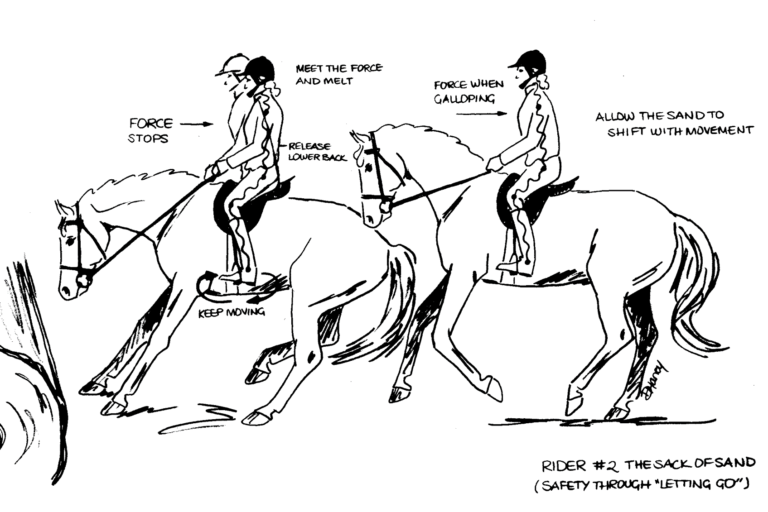
Next time you sit in the saddle have someone hold your horse while you try to these exercises. Sit straight up in the saddle and bring your knees up around the front of the skirt. You will be sitting like a jockey. Place one hand on your chest and one hand on your lower back and bend forward toward the horse’s neck. Notice you might want to bend over from the waist instead of bending from the hip joint.
Practice this until you feel you can bend from the hip joint, not at the waist, as one solid piece and you can move your legs independently with balance.
The second exercise is to drop your leg and have someone put one hand under the ball of your foot and the other hand on your thigh and try and lightly bounce your leg up and down. If you are aligned and moving from the hip joint your upper body will not move. If you are sitting too far forward and back on your pelvis your leg will not be separate from your body. Your upper body and pelvis stay still and secure while your leg can be bounced if you are in the correct neutral pelvic position.
Try these exercises standing, sitting and sitting in the saddle and let me know what you find!!
What issues are you having with these exercises?
Did you know that there’s only 1/16th of a difference in the female pelvis to be in or out of neutral position? Yikes that is a very small margin. So it’s time to get started finding it for yourself and I’ll guide you along the way through my blog posts!!!
I live and work in the U.K. in the county of Essex. I’m available for consultations, therapy and workshops either online or in person. You can check out my websites:
or contact me at marymidkiff@gmail.com
Big thanks to Peggy Cummings and connectedriding.com. Peggy started me off in the right direction and she is the best source for this approach to riding!!
I look forward to riding this journey with you. It makes such a difference to you and the horse!!🐎🐎
